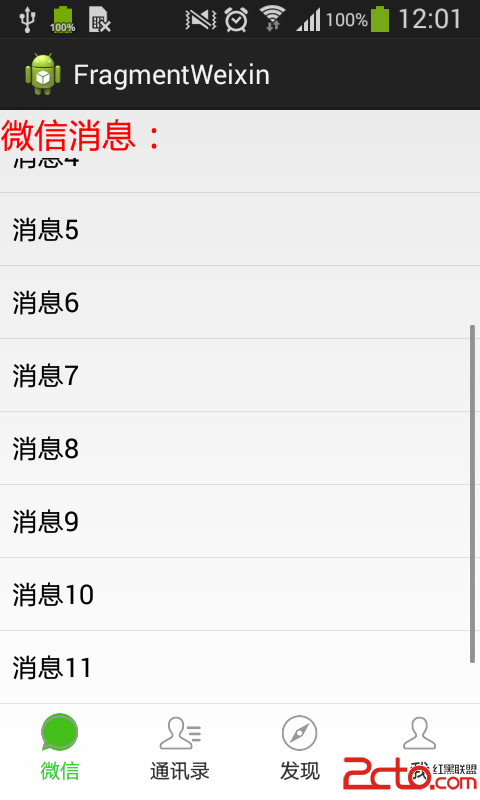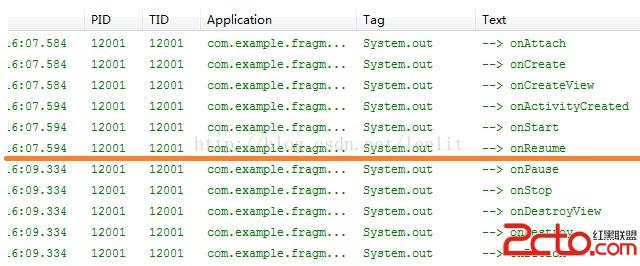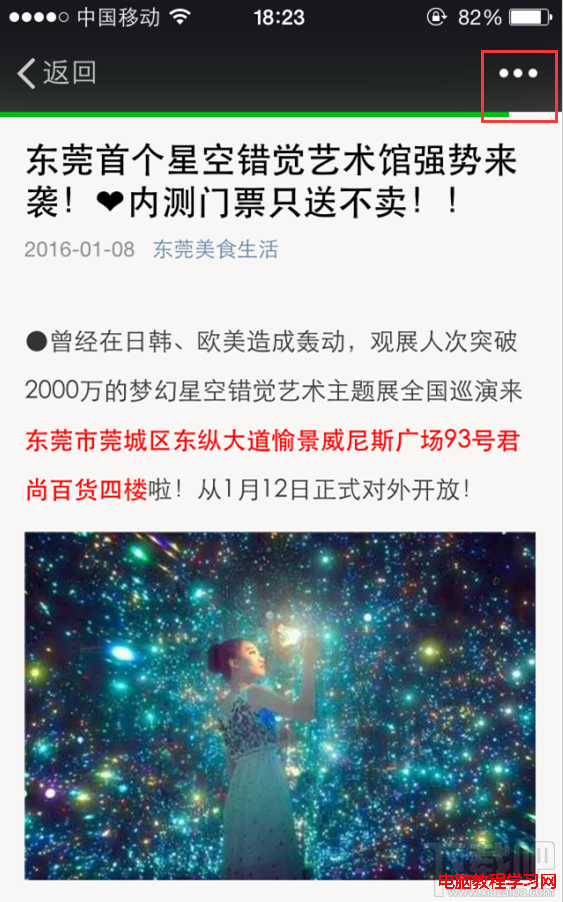編輯:關於Android編程
之前寫的第一篇Fragment實例,和大多數人一開始學的一樣,都是通過FragmentTransaction的replace方法來實現,replace方法相當於先移除remove()原來所有已存在的fragments,然後添加add()當前這個fragment。這就導致了一個問題,我們切換一次,然後再切換回來,相當於重新加載了這個fragment,原來的狀態不復存在,這顯然與我們的日常使用不符。想要保存切換後的狀態,思路還是很簡單的,我們先添加了若干fragments,切換後將所有fragments都隱藏hide(),並顯示show()切換後的fragment即可。
實例:山寨微信
由於代碼較長,這裡只講核心的部分,有興趣的可以下載源碼來看一下
public class MainActivity extends ActionBarActivity implements OnClickListener {
private View weixinLayout, tongxunluLayout, faxianLayout, woLayout;
private TextView weixinTv, tongxunluTv, faxianTv, woTv;
private ImageView weixinIv, tongxunluIv, faxianIv, woIv;
private Fragment1 fragment1;
private Fragment2 fragment2;
private Fragment3 fragment3;
private Fragment4 fragment4;
private FragmentManager fm;
@Override
protected void onCreate(Bundle savedInstanceState) {
super.onCreate(savedInstanceState);
setContentView(R.layout.activity_main);
// 初始化
initViews();
fm = getFragmentManager();
// 初識狀態是顯示微信
weixinIv.setBackgroundResource(R.drawable.weixin2);
weixinTv.setTextColor(getResources().getColor(R.color.green));
showFragment(1);
}
void initViews() {
// 注冊各IamgeView
weixinIv = (ImageView) findViewById(R.id.weixin_iv);
tongxunluIv = (ImageView) findViewById(R.id.tongxunlu_iv);
faxianIv = (ImageView) findViewById(R.id.faxian_iv);
woIv = (ImageView) findViewById(R.id.wo_iv);
// 注冊各TextView
weixinTv = (TextView) findViewById(R.id.weixin_tv);
tongxunluTv = (TextView) findViewById(R.id.tongxunlu_tv);
faxianTv = (TextView) findViewById(R.id.faxian_tv);
woTv = (TextView) findViewById(R.id.wo_tv);
// 注冊各Layout
weixinLayout = (View) findViewById(R.id.weixin_layout);
tongxunluLayout = (View) findViewById(R.id.tongxunlu_layout);
faxianLayout = (View) findViewById(R.id.faxian_layout);
woLayout = (View) findViewById(R.id.wo_layout);
// 各Layout注冊監聽器
weixinLayout.setOnClickListener(this);
tongxunluLayout.setOnClickListener(this);
faxianLayout.setOnClickListener(this);
woLayout.setOnClickListener(this);
}
@Override
public void onClick(View arg0) {
// TODO Auto-generated method stub
// 當點擊某個layout時,先清除狀態,這裡的狀態指的是布局裡面的圖片和文字
clearState();
switch (arg0.getId()) {
case R.id.weixin_layout:
// 如果點的是微信,將微信布局的圖片和文字的顏色變為綠色
weixinIv.setBackgroundResource(R.drawable.weixin2);
weixinTv.setTextColor(getResources().getColor(R.color.green));
// 顯示微信的fragment
showFragment(1);
break;
case R.id.tongxunlu_layout:
tongxunluIv.setBackgroundResource(R.drawable.tongxunlu2);
tongxunluTv.setTextColor(getResources().getColor(R.color.green));
showFragment(2);
break;
case R.id.faxian_layout:
faxianIv.setBackgroundResource(R.drawable.faxian2);
faxianTv.setTextColor(getResources().getColor(R.color.green));
showFragment(3);
break;
case R.id.wo_layout:
woIv.setBackgroundResource(R.drawable.wo2);
woTv.setTextColor(getResources().getColor(R.color.green));
showFragment(4);
break;
}
}
public void clearState() {
// 未選中時的圖片
weixinIv.setBackgroundResource(R.drawable.weixin1);
tongxunluIv.setBackgroundResource(R.drawable.tongxunlu1);
faxianIv.setBackgroundResource(R.drawable.faxian1);
woIv.setBackgroundResource(R.drawable.wo1);
// 未選中時字體顏色
weixinTv.setTextColor(getResources().getColor(R.color.black));
tongxunluTv.setTextColor(getResources().getColor(R.color.black));
faxianTv.setTextColor(getResources().getColor(R.color.black));
woTv.setTextColor(getResources().getColor(R.color.black));
}
public void showFragment(int index) {
FragmentTransaction ft = fm.beginTransaction();
// 想要顯示一個fragment,先隱藏所有fragment,防止重疊
hideFragments(ft);
switch (index) {
case 1:
// 如果fragment1已經存在則將其顯示出來
if (fragment1 != null)
ft.show(fragment1);
// 否則是第一次切換則添加fragment1,注意添加後是會顯示出來的,replace方法也是先remove後add
else {
fragment1 = new Fragment1();
ft.add(R.id.content, fragment1);
}
break;
case 2:
if (fragment2 != null)
ft.show(fragment2);
else {
fragment2 = new Fragment2();
ft.add(R.id.content, fragment2);
}
break;
case 3:
if (fragment3 != null)
ft.show(fragment3);
else {
fragment3 = new Fragment3();
ft.add(R.id.content, fragment3);
}
break;
case 4:
if (fragment4 != null)
ft.show(fragment4);
else {
fragment4 = new Fragment4();
ft.add(R.id.content, fragment4);
}
break;
}
ft.commit();
}
// 當fragment已被實例化,就隱藏起來
public void hideFragments(FragmentTransaction ft) {
if (fragment1 != null)
ft.hide(fragment1);
if (fragment2 != null)
ft.hide(fragment2);
if (fragment3 != null)
ft.hide(fragment3);
if (fragment4 != null)
ft.hide(fragment4);
}
}

引用上篇文章的fragment生命周期圖:

如果是repalce方法,我們切換至當前fragment則進行紅線以上的生命周期,切換到其他fragment後進行紅線以下的生命周期。但是,如果我們使用hide()和show()的方法,切換至當前fragment依然進行紅線以上的生命周期,切換到其他fragment後並沒有進行其他生命周期,只是簡單地隱藏了起來。這樣應該很明了了吧。
源碼:
http://download.csdn.net/detail/leelit/8179147
 AndroidNDK使用簡介
AndroidNDK使用簡介
今天我們來簡單說一下Android NDK的使用方法。眾所周知,so文件在Android的開發過程中起到了很重要的作用,無論與底層設備打交道還是在Android安全領域。
 最常用和最難用的Android控件ListView
最常用和最難用的Android控件ListView
ListView允許用戶通過手指上下滑動的方式將屏幕外的數據滾動到屏幕內,同時屏幕上原有的數據則會滾動出屏幕.1. ListView的簡單用法首先新建一個ListView
 Android編程繪制圓形圖片的方法
Android編程繪制圓形圖片的方法
本文實例講述了Android編程繪制圓形圖片的方法。分享給大家供大家參考,具體如下:效果圖如下:第一步:新建RoundView自定義控件繼承Viewpackage com
 微信如何轉發文章 微信轉發文章辦法
微信如何轉發文章 微信轉發文章辦法
微信如何轉發文章,使用微信,有時候會讀到一些覺得很好的文章,我們就想轉發分享給好友,那麼微信如何轉發文章呢,其實很簡單的,下面我就來一步一步的講解給大家。1